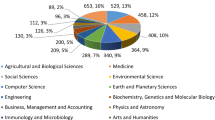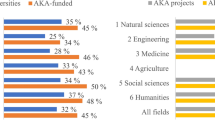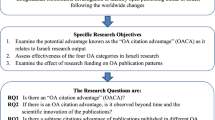Abstract
This study aimed to explore the determinants of quality, quantity, impact, and excellence of the research produced by the most productive and the highly cited researchers of Pakistan. The study also presented the profile of these impactful and the most prolific researchers of Pakistan. 134 highly cited and the most productive researchers constitute a group of PERs (Pakistani elite researchers). This group of elite researchers produced one-fourth of the country’s scholarly research and received 40% citations’ share over the period of study, from 2009 to 2018. Based on its findings the study provided multiple policy recommendations for researchers, research institutes, policy-makers, the government of Pakistan, and the administrators of universities. The study recommended the researchers to collaborate internationally and publish their research in good quality and open access journals for greater visibility and impact. The study further recommended enhancing the academic-corporate collaboration for user insight-based research. The study found that Islamabad based academic institutions have employed almost half of the elite researchers while the rest half of these researchers are affiliated with the institutions of the rest of the whole country. The majority of the journals publishing scholarly output of Pakistani elite researchers are based in the USA and European countries. Only 12 (0.32%) journals belonged to Pakistan. Besides international collaboration, industry collaboration was in place for this group of elite researchers. The key determinants of research quantity/quality, impact, and excellence were publications published in 1st and 2nd journals quartiles, journals having impact factor/citescore, open access publications, and international collaborations.



Similar content being viewed by others
References
Makri A. Pakistan and Egypt had highest rises in research output in 2018. Nature 2018.
Herciu I. Pakistan: Another BRIC in the Wall. 2016.
Shils E. The Academic Profession in India. In: Leach E, Mukherjee SN, editors. Elites in South Asia. Cambridge: Cambridge University Press; 1970. p. 172–200.
Rahman T. Language, education, and culture. Karachi: Oxford University Press; 1999.
Khattak SG. Research in difficult settings: reflections on Pakistan and Afghanistan, 2009.
Khalid SM, Fayyaz Khan M. Pakistan: the State of Education, 2006.
Warriach NF, Tahira M. Impact of Information and Communication Technologies on Research Development: a Case of University of the Punjab-Pakistan. Pak J Inf Manag Libr. 2014;15:47–53.
Mahmood K, Shafique F. Changing research scenario in Pakistan and demand for research qualified LIS professionals. Libr Rev. 2010;59(4):291–303.
Lodhi AS. A pilot study of researching the research culture in Pakistani public universities: the academics’ perspective. Procedia Soc Behav Sci. 2012;31(2011):473–9.
Chan TH, Tse CH. Profiling Lead Researchers in Advertising Research. In: Advances in Advertising Research, vol. VII. Wiesbaden: Springer; 2017, p. 297–315.
Basu A. Using ISI’s ‘highly cited researchers’ to obtain a country level indicator of citation excellence. Scientometrics. 2006;68(3):361–75.
Abramo G, Cicero T, D’Angelo CA. Are the authors of highly cited articles also the most productive ones ? J Informetr. 2014;8(1):89–97.
Parker JN, Allesina S, Lortie CJ. Characterizing a scientific elite (B): Publication and citation patterns of the most highly cited scientists in environmental science and ecology. Scientometrics. 2013;94(2):469–80.
Stern RS, Arndt KA. Top-cited dermatology authors publishing in 5 ‘high-impact’ general medical journals. Arch Dermatol. 2000;136(3):357–61.
Peng MW, Zhou JQ. Most cited articles and authors in global strategy research. J Int Manag. 2006;12(4):490–508.
Docampo D, Cram L. Highly cited researchers: a moving target. Scientometrics. 2019;118(3):1011–25.
Podlubny I, Kassayova K. Towards a better list of citation superstars: compiling a multidisciplinary list of highly cited researchers. Res Eval. 2006;15(3):154–62.
Goodall AH. Highly cited leaders and the performance of research universities. Res Policy. 2009;38(7):1079–92.
Larivière V, Costas R. How many is too many? On the relationship between research productivity and impact. PLoS ONE. 2016;11(9):e0162709.
Hayati Z, Ebrahimy S. Correlation between quality and quantity in scientific production : A case study of Iranian organizations from 1997 to 2006 Correlation between quality and quantity in scientific production : a case study of Iranian organizations from 1997 to 2006; 2009.
Bosquet C, Combes PP. Are academics who publish more also more cited? Individual determinants of publication and citation records. Scientometrics. 2013;97(3):831–57.
Sandströ U, Van Den Besselaar P. Quantity and/or quality? The importance of Publishing Many Papers, 2016.
Tahamtan I, Safipour Afshar A, Ahamdzadeh K. Factors affecting number of citations: a comprehensive review of the literature. Scientometrics. 2016;107(3):1195–225.
Rutledge R, Karim K. Determinants of coauthorship for the most productive authors of accounting literature. J Educ Bus. 2009;84(3):130–4.
Confraria H, Blanckenberg J, Swart C. The characteristics of highly cited researchers in Africa. Res Eval. 2018;27(3):222–37.
Parker JN, Lortie C, Allesina S. Characterizing a scientific elite: The social characteristics of the most highly cited scientists in environmental science and ecology. Scientometrics. 2010;85(1):129–43.
Bornmann L, Bauer J, Schlagberger EM. Characteristics of highly cited researchers 2015 in Germany. Scientometrics. 2017;111(1):543–5.
Mayrath MC. Attributions of productive authors in educational psychology journals. Educ Psychol Rev. 2008;20(1):41–56.
Crase D. Highly productive scholars: what drives them toward success? J Phys Educ Recreat Danc. 1993;64(6):80–3.
Javed Y, Ahmad S, Khahro SH. Evaluating the Research Performance of Islamabad-Based Higher Education Institutes. SAGE Open. 2020;10(1):2158244020902085.
Mahbuba D, Rousseau R. Scientific research in the Indian subcontinent: selected trends and indicators 1973–2007 comparing Bangladesh, Pakistan and Sri Lanka with India, the local giant. Scientometrics. 2010;84(2):403–20.
Uddin A, Singh VK. Measuring research output and collaboration in South Asian countries. Curr Sci. 2014;107:31–8.
Javed SA, Liu S. Predicting the research output/growth of selected countries: application of Even GM (1, 1) and NDGM models. Scientometrics. 2018;115(1):395–413.
Badar K, Hite JM, Badir YF. Examining the relationship of co-authorship network centrality and gender on academic research performance: the case of chemistry researchers in Pakistan. Scientometrics. 2013;94(2):755–75.
Bajwa RS, Yaldram K. Bibliometric analysis of biotechnology research in Pakistan. Scientometrics. 2013;95(2):529–40.
Jan SU. Collaborative research in economics in Pakistan: the case of Pakistan Development Review from 1973 to 2009. Libr Philos Pract. 2013;1016:171–81.
Naseer MM, Mahmood K. Use of bibliometrics in LIS research. Libres. 2009;19(2):1–11.
Qayyum M, Naseer MM. Bio-bibliometric Study of Dr. Khalid Mahmood’s Contributions to LIS Field in Pakistan. Libr Philos Pract, 2013; 16.
Kousar M, Mahmood K. Dr. Syed Jalaludin Haider: A bio-bibliometric study. Pak J Libr Inf Sci 2010.
Kwiek M. The European research elite: a cross-national study of highly productive academics in 11 countries. High Educ. 2016;71(3):379–97.
de Freitas S, Mayer I, Arnab S, Marshal I. Industrial and academic collaboration: hybrid models for research and innovation diffusion. J High Educ Policy Manag. 2014;36(1):2–14.
Abramo G, D’Angelo CA, Solazzi M. The relationship between scientists’ research performance and the degree of internationalization of their research. Scientometrics. 2011;86(3):629–43.
Wang L, Thijs B, Glänzel W. Characteristics of international collaboration in sport sciences publications and its influence on citation impact. Scientometrics. 2015;105(2):843–62.
Author information
Authors and Affiliations
Corresponding author
Additional information
Publisher's Note
Springer Nature remains neutral with regard to jurisdictional claims in published maps and institutional affiliations.
Rights and permissions
About this article
Cite this article
Ahmad, S., Qureshi, I.U., Ramzan, M. et al. Research Elite of Pakistan: Profile and Determinants of Productivity and Impact. Pub Res Q 38, 263–280 (2022). https://doi.org/10.1007/s12109-022-09874-5
Accepted:
Published:
Issue Date:
DOI: https://doi.org/10.1007/s12109-022-09874-5




